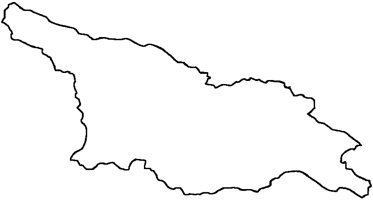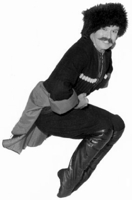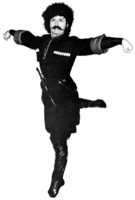
|
The Society of Folk Dance Historians (SFDH)
Dances of Georgia
[
Home |
About |
Encyclopedia | CLICK AN IMAGE TO ENLARGE |

|
 Few people why have seen Georgian dance forget it soon. It is as exciting to an audience as it is challenging to the dancer. The graceful gliding of the women, the fierce and complicated men's steps, many done on the toes or knees, and the restrained chivalry of the couple dances, all combine to make this dance form one of the world's most interesting, and one of Georgia's chief exports to the world of culture.
Few people why have seen Georgian dance forget it soon. It is as exciting to an audience as it is challenging to the dancer. The graceful gliding of the women, the fierce and complicated men's steps, many done on the toes or knees, and the restrained chivalry of the couple dances, all combine to make this dance form one of the world's most interesting, and one of Georgia's chief exports to the world of culture.
Georgian culture and Georgian dance can trace their roots back several centuries before Christ. The types of dances that existed in early times were pagan ritual, agricultural, military, religious, Shairebi (song-dances), work, hunting dances, and dances imitating the movements of animals. During a later period of development, wedding, love, entertainment, athletic, and competitive dances came into being. During the medieval period, the Georgian court developed solo and duet dances, and Sdarbazo (palace dances). (Dzhavrishvili, 1975: 8-9)
The unique style of Georgian dance owes its origins and continuity to the strict fundamental aspect of social restraint in Georgian culture. All the social rules that keep a tight hold on the behavior of the Georgian people are clearly exemplified, perhaps even epitomized, in their dances and makes this particular form of dance extremely interesting from an ethnological point of view. Dancing and singing are two of the very few opportunities that Georgians have to let out frustrations and express emotions in public. In a culture where to touch or to be touched is extremely significant, dancing is a very intense social activity as it brings men and women into close contact. Dancing in Georgia has been an integral part of courtship.
The ideal steyle for both men and women is restricted carriage, a rigid spine, and little bending at the waist. Additionally, the ability to dance smoothly and glide across the floor at any musical tempo is not only admired but expected.
Women's dance movements are stylistically lyrical, graceful, and reserved. Carriage and the immobility of the body are most important. Small, delicate footsteps are used to produce the illusion of gliding or floating. Expressive movement is in the use of the arms and hands in a lyrical way with the ideal being simplicity and ease of movement. While dancing, a Georgian woman maintains an expression of restraint, self-respect, regality, and reservation that manifests itself in rarely glancing at the man.
MEN'S DANCE

 Men's dancing is almost in direct contrast to that of the women's. While dancing with a woman, a Georgian man maintains all the ideals of chivalry and yet is assertive and dynamic. While dancing alone or with other men, his movements become explosive, fiery, and very energetic. Men's dancing can be delineated best into three areas of movement: regular dancing on the feet, toe dancing, and dancing on the knees.
Men's dancing is almost in direct contrast to that of the women's. While dancing with a woman, a Georgian man maintains all the ideals of chivalry and yet is assertive and dynamic. While dancing alone or with other men, his movements become explosive, fiery, and very energetic. Men's dancing can be delineated best into three areas of movement: regular dancing on the feet, toe dancing, and dancing on the knees.
Dancing on the feet can be broken down into two categories: movements of locomotion and movements in place. There are about four movements of locomotion; and during every one of them, from a simple, slow walk to the fast and distance-covering skipping step, the dancer's body remains at one constant level, that is, glides smoothly across the floor. Movements in place on the other hand may be smooth or may frequently change level.
Dancing on the toes is accomplished in unpadded boots by knuckling under the toes and placing the weight on the tops (dorsal surface) of the toes. Movements that are performed on the toes include walking, running, jumping, hopping, and sometimes even turning. The origins and development of toe dancing are rather vague, although one hears many romantic suppositions. The best opinion is that the origins are probably tied up in the customs of proving strength (and the ability to withstand pain) as men and warriors. There is conflicting information regarding how much toe dancing, if any, is done when dancing with a woman.
Movements that are done on the knees are limited to various forms of falls or drops onto the knees, turns in the air from the knees, single spins, and continuous turns on the knees while moving around the dance floor. Most of these knee movements are accomplished by placing the weight not only upon the knees, but also upon the legs, ankles, and feet (with the toe pointed back in plantar flexion). In this way, the stres of landing on the knees is shared by the leg and foot, thereby making it less traumatic for the knee joint.
GEORGIAN DANCES
Georgian dance researcher David L. Dzhavrishvili identifies twenty-five Georgian dances by name and suggests that there are even more (1975:12). Of those dances listed, nine have been seen by Americans when Georgian dance ensembles presented their concerts here. They are Perkhuli, Khorwni, Mkhedruli, Taeruli, Samaya, Bagaduri, Gandagan, Davluri, and the best known of all, Kartuli.
Kartuli is a dance of courtship and chivalry governed by many elaborate rules restricting the interplay between the man and woman. Khorumi is a dance from Adjaristan (southwestern Georgia) and is traditionally done by five men accompanied in a 5/4 meter. It is an ancient dance-ritual based on a military theme in which the dancers reenact a scouting party.
Several other dances, not mentioned by Dzhavrishvili, are also favorites among western audiences. Simd, dating from antiquity, is a graceful and flowing dance that has traditionally been done by an unlimited number of couples at weddings and other large festive occasions. It is a procession dance similar in form to the Polish Polonaise or the American Grand March. It is one of the very few instances in Georgian dance in which partners actually touch one another.
But perhaps the best known of all the dances of the Caucasus is Lezghinka. The name stems from the Lezghinkas of Daghestan. While Russian immigrants in America use the name Lezghinka to refer to both the men's competition dance and the couple dance Kartuli, the Georgians call the men's dance by an entirely different name, Lekuri. As anyone who has seen it knows, it is a spectacular toe dance in which the fierce competition and the bravura displayed by the men best exemplifies the militancy of their heritage.
Lezghinka is the perfect example of the appeal of Georgian dance to American audiences. To the uninitiated theatre-goer there seems to be an unending amount of walking around the stage, reinforced by repetitive music that seems to lead to only monotony. Then, suddenly, an unexpected movement of great virtuosity on toes or knees brings an audience to their feet. While most of the toe routines were in fact developed by the state choreographic school (the villager did far less), it still is testimony to virtuosity of Georgian dancing and clear explanation of why so many American folk dancers have become devotees of Georgian dance.
REFERENCE
- Dzhavrishvili, David L. Gruzinekie Narodnie Tantsy. Tbilisi: Iztatel'stvo Ganatelba, 1975.
DOCUMENTS
- Folk Music and Dance of Georgia, an article.
- Georgia, a country.
- Peoples of the North Caucasus, an article.
- Transcaucasia, a region.
Used with permission of the author.
Printed in Folk Dance Scene, March 1983.
This page © 2018 by Ron Houston.
Please do not copy any part of this page without including this copyright notice.
Please do not copy small portions out of context.
Please do not copy large portions without permission from Ron Houston.